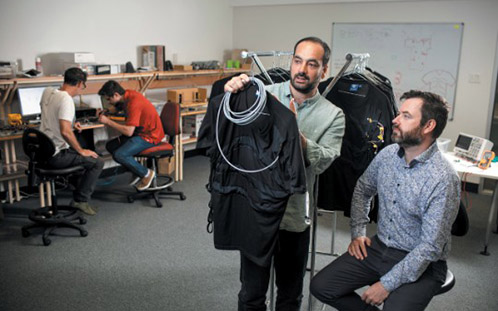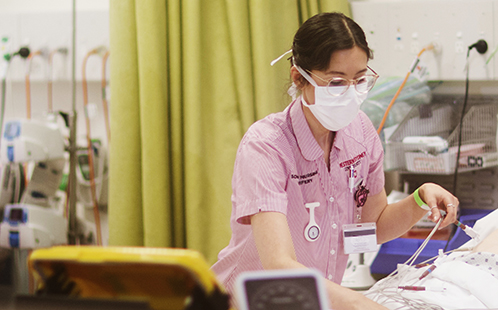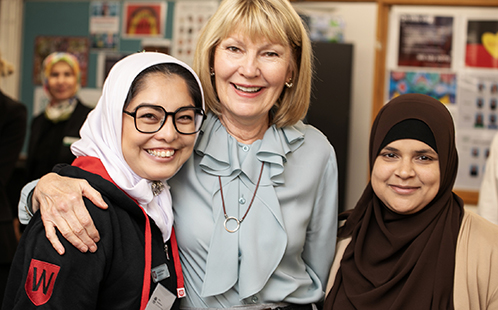A t-shirt that monitors your breathing? It’s not science fiction

Associate Professors Gaetano Gargiulo and Paul Breen examining new Saiiv technology developed at Western Sydney University’s MARCS Institute for Brain, Behaviour and Development
The following article by Linda Music, South West Sydney Research, was first published with full links on South West Sydney Research's website (opens in a new window).
Imagine a t-shirt that can monitor your breathing, your heart rate, your temperature, even your unborn baby’s kicks and heartbeat.
While it may sound like something from a sci-fi film, researchers at Western Sydney University have developed a t-shirt which can do just that.
‘Saiiv’ is a wearable vital signs monitoring device in the form of a t-shirt which may, one day, be used by people with sleep apnoea, heart disease, pregnant women, and even COVID-19 patients.
‘Saiiv’ is the brainchild of Associate Professor Paul Breen and Associate Professor Gaetano Gargiulo from Western Sydney University’s MARCS Institute for Brain, Behaviour and Development who first had the idea for a wearable monitoring device in 2013.
“It started with a conversation between Gaetano and I about better ways to monitor human physiology,” explains Associate Professor Breen.
They started ‘playing around’ with different polymers to find one that was not only suitable to embed sensors into, but could also be purchased at a low cost and was available at scale.
“There are a lot of monitoring devices out there, but they tend to be quite expensive. To be able to use this in a clinical setting, we wanted to ensure that the material could be purchased by the metre at a low cost”, said Associate Professor Breen.
“We also wanted the t-shirt to be lightweight and comfortable and for the sensors to be embedded so that they can’t be seen. We’re trying to create ‘invisibles’,” he said.
Initially, they started by looking at developing a wearable device to monitor blood flow in the legs. However, they quickly realised they could use the same technology for the chest to measure respiration and heartbeat.
Associate Professors Breen and Gargiulo and their team are now part of a Cooperative Research Centre project, where their technology is focused mainly on developing wearable monitoring devices for diagnosing sleep apnea. Results to date have been very promising.
In their most recent paper published in Sensors (March 2020), Associate Professors Breen and Gargiulo and PhD student,Titus Jayarathna, showed that Saiiv was successful in detecting respiration rate with a sensitivity of 99.44 per cent during sleep.
The morphic band embedded in the t-shirt ‘morphs’ to the human body allowing the wearer to sleep comfortably in all positions with minimal differences in data quality. The same study showed that the device captured breathing during gait with 88.9 per cent to100 per cent accuracy.
“Being able to monitor a patient during their daily activity is a huge advantage if we want a wholistic view of their health, not just at specific points in time” says Associate Professor Breen.
The team has also developed a version of the Saiiv t-shirt for pregnant women which can simultaneously monitor the heart rate of ‘mums-to-be’ as well as fetal movement and heartbeat.
In response to COVID-19, the group has also developed a wearable waistband which, they believe, could allow patients to stay at home while still having their vital signs, including respiration, heart rate and temperature, monitored.
COVID-19 is a respiratory disease, but few available devices can accurately and directly monitor respiration. Associate Professor Breen explains that the advantage of their device is its effectiveness at measuring respiration.
“We can directly measure respiration rate and respiration effort by looking at how the chest is moving in relation to the abdomen and we can do this at fraction of the cost of the other wearables that are out there. Our technology is an ideal solution that can also capture important metrics like heart rate and temperature”, he said.
The group has built a few prototypes and are gearing up for clinical trials which, they believe, will show that the device works and has value with a view to turning it into a realisable product.
“We’re working really hard with our clinical and industry partners to have this product available as a TGA-approved product as soon as possible,” says Associate Professor Breen.
While Associate Professor Breen acknowledges that Australia is faring better than most countries with the COVID-19 outbreak, he explains that potential exists for the product to be used by other countries.
“We don’t know if there will be a relapse of the outbreak or if this will be a future event so now is the time to get ready. From our conversations with clinician colleagues, this technology will be of considerable use outside of the pandemic to provide at-home monitoring where it’s needed and keep patients out of hospital,” says Associate Professor Breen.
ENDS
6 May 2020
Latest News

Western Sydney University ranks among world’s best for 23 subjects
The University has been named as one of the world’s top universities for the study of 23 subjects in the latest edition of the QS World University Rankings by Subject, including being ranked in the top 50 for Nursing.

Western Sydney University receives landmark $7.9 million philanthropic gift from Harvey Norman to launch leadership academy, empowering young women in Western Sydney
Western has welcomed a landmark donation to establish the Harvey Norman® Young Women’s Leadership Academy Led by Katie Page.

Opinion: How much sport will you be able to watch for free under proposed new Australian broadcast rules?
Watching sport on television and other screens is integral to the cultural lives of many Australians.
Mobile options:

